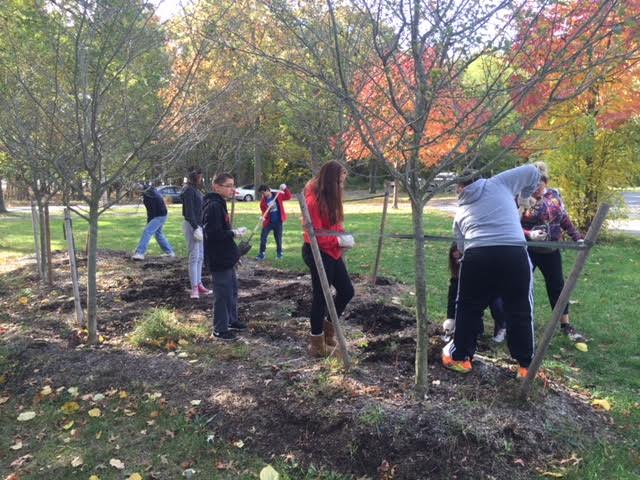Nerves are still raw in Tottenville six years after Hurricane Sandy devastated this shoreline community. A father and daughter died when the storm water swept through their home. Photos by Anthony J. Reinhart
A Talk With Living Breakwaters Citizen Advisory Member Jim Pistilli
Jim Pistilli, a native Staten Islander, has lived in Tottenville for 45 years, and witnessed firsthand the devastation that storms have wreaked on his community. In the immediate aftermath of Hurricane Sandy in the fall of 2012, he and fellow members of the Tottenville Civic Association raised $10,000 to aid Tottenville families who were devastated by the storm.
In 2012 he joined the New York Rising Community Reconstruction process on Staten Island, which gave rise to what is now known as the Shoreline Protection project. Both Living Breakwaters and the Shoreline Protection projects together represent a multi-pronged approach to addressing storm resiliency along the Tottenville shore, where a father and daughter were swept from their house and perished during Sandy, the deadly storm that wreaked havoc throughout the New York City region.
As co-chair of the Living Breakwaters and Tottenville Shoreline Protection Citizen’s Advisory Commission with Victoria Cerillo, Pistilli has kept a close eye on the evolution of both projects. He reports that they have enjoyed long-standing local community support and that residents have had ongoing opportunities to engage in every step of the design process. Nonetheless, he notes, pockets of opposition have arisen from some residents who live along the shoreline.
Members of the Tottenville Civic Association spend a fall day tending to the grounds of Conference House Park.
Pistilli is also frustrated by the spread of misinformation about the project. “There has been a lot of misconstruing that the Breakwaters will become an obstruction, that the materials used are not eco friendly, that ships will crash into them, that they will ice over,” he says. “The irony is the reason why this project is five years in development is that it has to respond to every agency within its jurisdiction. For example, The Coast Guard says it is out of the shipping channel. A tremendous amount of science has been put into looking at the tide flow. My response to the naysayers is take the time to look at the intensity of study that is going on and has gone on and modifications that have been made, and will continue to be made, in response to the study and to community input.”
We also talked with Pistilli, who has been president of the Tottenville Civic Association for the past five years, about Main Street’s decline and how to reverse it. He remembers when it was the common space that knitted the community together, when you could get all your daily needs from local merchants there and run into neighbors with whom you would discuss community issues. “The challenge," he says, "is to come up with a solution to reinitialize some of Main Street’s charm” in a way that reflects what the community and local economy need to thrive today.
There are clearly some low-hanging fruit to be addressed, he points out, like the one-way flow of traffic on Main Street in the wrong direction, which cuts it off the newer smaller shops and restaurants on Amboy Road. Then there is the larger issue of the strip-mallification of the South Shore, a problem that is a lot harder to tackle: “Our community is a mile away from Page Avenue, now a massive shopping area, and the big box stores," he reports. "It is hard competition for Main Street.” Another pervasive problem, he reports, is that many current property owners on Main Street don’t want to make concessions to help new businesses get on their feet. “How do you go for years with an empty building and demand such high rents?” he asks.
Pistilli does glimpse some promising signs on the horizon. For example, the new owners of a nine-unit residential condo development at 203 Main Street, which has been vacant for ten years, have cleared up existing violations and preparing the structure for occupancy. “It will take a derelict building and creates foot traffic and will help generate some revitalization,” he maintains. “Or that is what we are hoping.” He is also confident that the Living Breakwaters project, once completed, will draw people to Main Street. “When people come to visit this project," he maintains, “there will be all sorts of things that can be done to connect the dots.”
“The plans have always been to have total connectivity from the Conference House Park Visitor’s Center all along the shoreline to Page Avenue so people can utilize it more fully,” he says. “There are many residents who look forward to the opportunity to jog, stroll, and expose their children to marine activities. But some people who live along the shore feel their privacy will be invaded even though all planned improvements will be on public land.” Pistilli is nonetheless optimistic that through continued dialog those concerns can be ameliorated. “When you live through something like Sandy you have to push for the resiliency and protection that will prevent it from happening again,” he says. But he is even more motivated to see the improvements made because they will also mitigate the ongoing erosion that is decimating the Tottenville shoreline, submerging parts of what were once navigable shore roads.





